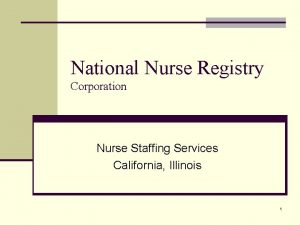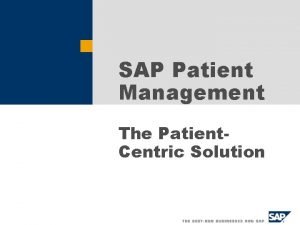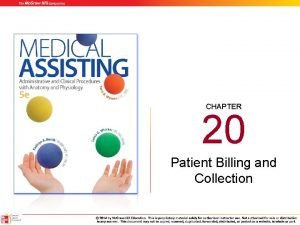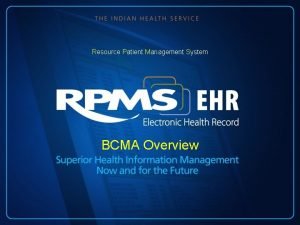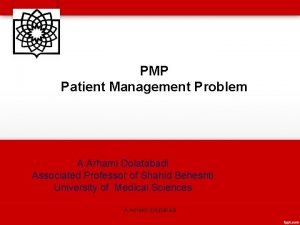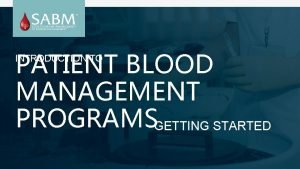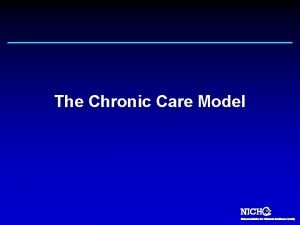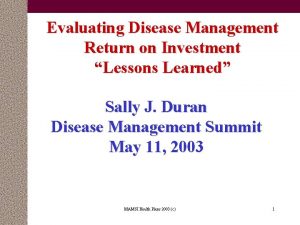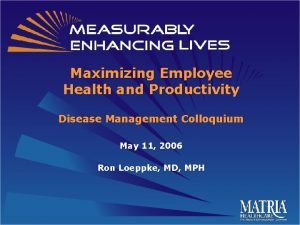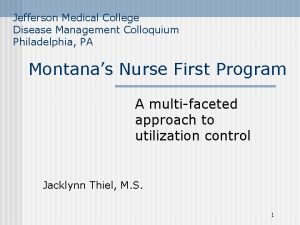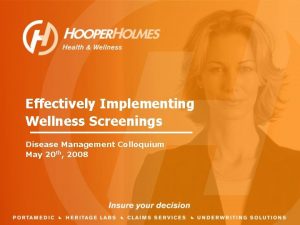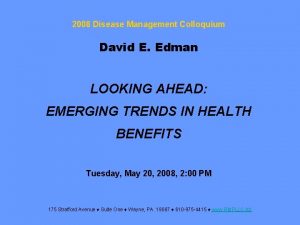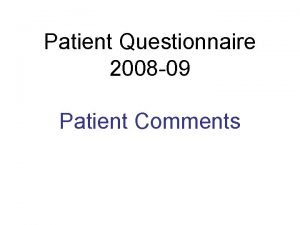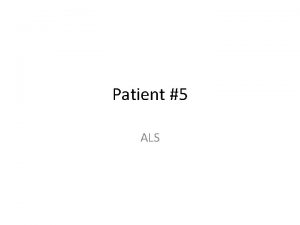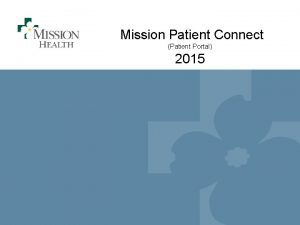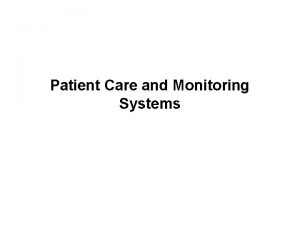Disease Management Colloquium Using Registries to Manage Patient
































- Slides: 32

Disease Management Colloquium Using Registries to Manage Patient Care Art Sprenkle, MD Medical Director: Mc. Kesson Health Solutions; Washington State Medical Education & Research Foundation

Improve Quality of Care through the Use of Patient Registries Washington State Medical Education Research Foundation

Arthur C. Sprenkle, MD n 17 years medical practice n 3 terms, Washington State Legislature n 4 years, health plan medical director n 5 years, Medical Director, Mc. Kesson Health Solutions

Arthur C. Sprenkle, MD n Washington State Medical Education and Research Foundation (WSMERF) n Director: n n Washington State Appropriate Antibiotic Use Campaign Washington Quality Improvement Program

Washington Quality Improvement Program n Two year program n State-wide n n Physician-specific patient-identified registries for chronic and preventive care Physician practice and prescribing reports

Washington Quality Improvement Program (cont) n Provide physician validated and supported elements of the new system in a timely fashion n n Guidelines Metrics Measures of performance Chronic and preventive care registries

Why Is This Needed n n There is a fundamental need for physicians to be provided with comprehensive, consistent, timely, accurate information upon which they can make decisions. This information currently exists but is not being made available.

Chronic Care WG n Recommendation – Dr. Al Fisk, Medical Director, The Everett Clinic “The least difficult and most valuable thing the health plans could do to support improved chronic illness care would be to provide physicians with the names of all their patients with these conditions and their health status as reflected in medical claims. ”

Must have data to justify change n Data set critical n n Must represent a large percentage of a physician’s total practice Must be trusted n n Must have physician ownership and buy-in Best accomplished through participation in development, validation and implementation

CORE CONCEPTS n n n All health plans use the same doctors Doctors largely treat all patients the same regardless of health plan No one payer has the ability to invest the required resources to substantively change physician behavior

CORE CONCEPTS (cont) n n n Interventions need to be comprehensive and sustained in order to be effective Most interventions need to involve the public as well as the delivery system Large data sets (larger than any one plan has) are required to get accurate data and to get the doctors’ attention

CORE CONCEPTS (cont) n n n All doctors must be included More than 50% of primary care is provided by groups of 5 or fewer practitioners Most current QI directed at larger groups:

Program Components n n n Physician specific patient registry reports Physician specific practice and prescribing reports (de-identified/aggregated data) Guidelines and Metrics

Process to obtain physician buy-in n n Large number of medical groups, specialty societies, health plans, WADOH, university faculty Comprehensive transparent validation process to be certain measurements are an accurate representation of what is really taking place in practice.

Report characteristics n n Initial target: all primary care practitioners in the state Combined medical and pharmacy claims data from as many payers as possible (hopefully all payers) Updated quarterly Web-based

Report characteristics (cont) n Chronic conditions n n n n Diabetes Asthma Heart disease Depression Prevention Cancer screening Immunizations

Registry Reports n Physician specific comprehensive patient lists: n All patients associated with a physician identified as the primary care giver n Provides status of appropriate care measures as can be measured through claims data. n Available to be downloaded into new or existing registries

Best Practices The reports that are generated by this program focus on key clinical indicators that can be accurately measured from claims data and can support physicians’ in their efforts to provide the highest possible quality of care. The following are the measures that we will track and the evidence for using them

Conditions and situations 1. 2. 3. 4. 5. 6. 7. 8. Diabetes Coronary artery disease Heart Failure Asthma Depression Cancer screening Immunization status Antibiotics for acute respiratory infection

PREVENTION 1. 2. Childhood immunizations Cancer screening 1. 2. 3. Breast Cervical Colon

Experience with Registries 1. Washington State Medical Education and Research Foundation QI Initiative 1. 2. Chronic Care Registry Mc. Kesson Health Solutions Medicaid DM Programs 1. 2. Registry Reports DM Registry

Justification 1. Central Element of Chronic Care Model 1. 2. Initially just diabetes patients Evolving to include multiple chronic and preventive conditions Improve Quality

Objective 1. 2. Re-enforce Primary Care Medical Home Concept Emphasize Scheduled Visits and Preventive Services

Purpose 1. 2. 3. Create a process to improve quality of care provided Identify and track all participants with a condition or needing services Evolve from acute care to scheduled visit/preventive care medicine

Purpose (cont) 1. Initially the centerpiece of the Chronic Care Model approach to chronic condition management 1. Identify and track all individuals with a condition 1. 2. Identify and track all evidence-based measures for that condition Able to identify and correct deficiencies in a systematic way

Problem(s) 1. Financial 1. 2. Practice viability of primary care Time 1. 2. EMR competition Practice redesign

Financial - History 1. Initial tremendous emphasis nationwide as part of Diabetes Collaborative Initiative 1. 2. Grant and federal (FQHCs) funding to start Registries provided for free 1. 2. DEMS PECS

Financial – History (cont) 1. Currently stalling 1. No institutional funding except for FQHCs 1. 2. 3. None of elements supported by current insurance Primary care struggling for economic survival Small practices not included in process initially

Financial – History (cont) 1. 2. One FTE required for every 5000 registry entries Financial incentives (Pay for Performance) currently not in place in most areas of the country to justify physicians investing time or money

Time 1. Competition with implementation of EMR 1. 2. Most EMRs do not have registry function Practice redesign/management for practice viability

Possible Solution 1. Digitalize all information 1. Eliminate most of the staff time required to “care and feed” registry 2. Multiple/All payers 3. Web-based 1. 2. Secure download CD

Questions
 Colucci v colucci scc
Colucci v colucci scc Nurseregistry
Nurseregistry Patient 2 patient
Patient 2 patient Patient counselling for peptic ulcer disease
Patient counselling for peptic ulcer disease Communicable disease and non communicable disease
Communicable disease and non communicable disease Money management decisions attempt to manage a firm's
Money management decisions attempt to manage a firm's Lesson 27 using diet to guard against disease
Lesson 27 using diet to guard against disease Sap patient management
Sap patient management Nursing diagnosis on ocd
Nursing diagnosis on ocd Chapter 20 patient collections and financial management
Chapter 20 patient collections and financial management Resource patient management system
Resource patient management system Preoperative nursing management of cataract
Preoperative nursing management of cataract Patient management problem
Patient management problem Patient blood management definition
Patient blood management definition What is nursing management of a patient
What is nursing management of a patient Hospital web application
Hospital web application Patient safety incident management system
Patient safety incident management system Bivalve cast compartment syndrome
Bivalve cast compartment syndrome Nursing care for gastrointestinal disorders
Nursing care for gastrointestinal disorders Hirschsprung disease nursing management
Hirschsprung disease nursing management Kate lorig stanford
Kate lorig stanford Disease management association of america
Disease management association of america Developedbyed
Developedbyed Stages of cirrhosis of the liver
Stages of cirrhosis of the liver Disease management roi
Disease management roi Deka vitaminok
Deka vitaminok Mdipa/oci
Mdipa/oci Paradigma let the manager manage
Paradigma let the manager manage Keep satisfied manage closely monitor keep informed
Keep satisfied manage closely monitor keep informed Stakeholders mapping
Stakeholders mapping Direct and manage project execution
Direct and manage project execution Kata manajemen berasal dari kata manage dari bahasa
Kata manajemen berasal dari kata manage dari bahasa Manage men
Manage men

